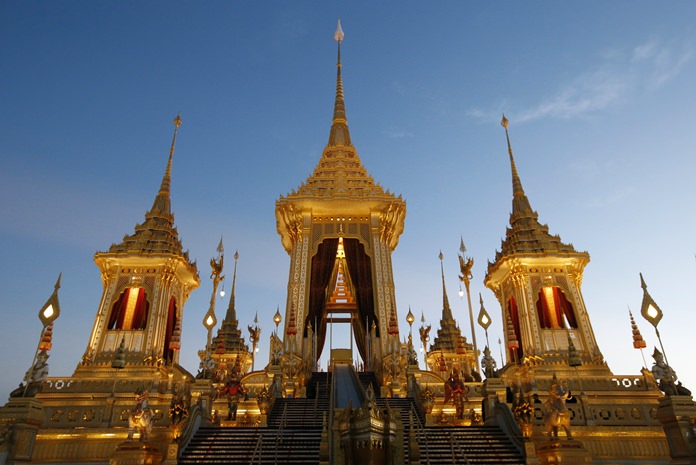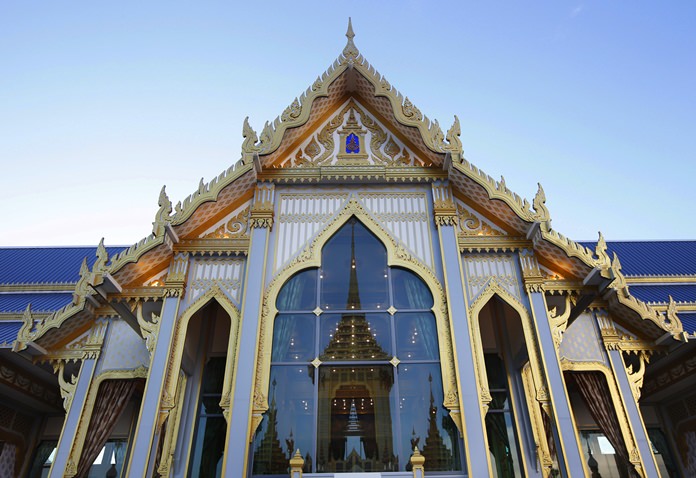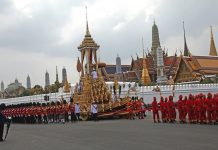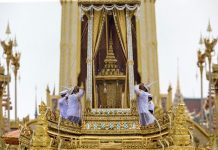
Referred to as Phra Merumas (Golden Crematorium), the Royal Crematorium is where the Royal Urn is placed on the pyre (Phra Chittakathan), for the cremation. Traditionally, it was built as a temporary construction in the middle of the city for cremating a deceased king or queen, or high-ranking royal, and was recorded for the first time in the Ayutthaya period.
Support Pattaya Mail – Click Here
The Royal Crematorium is modeled after the imaginary Mount Sumeru, the center of the universe in Buddhist cosmology. In the ancient Thai kingdom, the concept of a divine king was firmly established and institutionalized, and it was influenced by Hinduism and deism. To represent this concept, the artists and architects used their imagination in the construction of the Royal Crematorium.

The Fine Arts Department was assigned to design and construct the Royal Crematorium for His Majesty King Bhumibol Adulyadej. The Royal Crematorium comprises nine spire-roofed pavilions (busabok) rising from the base, which is formed in three levels.
The principal pavilion is in the middle and is the centerpiece of the ceremony, with the pyre for the setting up of the Royal Urn to be cremated and fire screens. The Nine-tiered Great White Umbrella of State is placed at the top of the principal pavilion. There are stairs in the four directions. The western part of the Royal Crematorium faces the Royal Merit-Making Pavilion (Phra Thinang Song Tham).
The structure measures 50.49 meters from the base to the top. It is made of wood, with an inner steel structure. The “heavenly pond” is found in the four directions of the Royal Crematorium base and is also decorated with auspicious animals, namely elephants, horses, cows, and lions. Sculptures of mythical creatures that exist in the Himmaphan (Himavanta) Forest, surround the base of Mount Sumeru.
There are also sculptures of Khun Tongdaeng and Khun Jo Cho, His Majesty King Bhumibol’s pet dogs, to be placed in the principal pavilion of the Royal Crematorium.
The first level is surrounded with the ceremonial fence, or enclosure (Rajawat). The figures of Thao Chatulokkaban, or the four guardians of the world, are found at the four corners.

The second level consists of the Dismantling Halls (Ho Plueang), where the Outer Royal Urn and the Sandalwood Royal Urn will be kept, as well as other items used in the Royal Cremation Ceremony. There are also six sculptures of Garuda (a mythical figure that is half bird, half human).
The third level comprises the Monks’ Pavilions (Sang) at the four corners of the Royal Crematorium, for monks who will chant scriptures.
The magnificent Royal Crematorium is also decorated with eight standing celestial beings and 32 celestial beings in a kneeling position.

There are two elevated royal pavilions. One is located at Sanam Luang, and the other at Wat Phra Chetuphon. The elevated royal pavilion at the ceremonial site is for His Majesty the King and members of the Royal Family to use in receiving the royal Urn from the Royal Chariot into the ceremonial site.
The Elevated Royal Pavilion in front of Wat Phra Chetuphon, is reserved for His Majesty the King and members of the Royal Family, while the Royal Urn is moved from the Golden Palanquin on to the Great Victory Chariot.

The Royal Merit-Making Pavilion is a hall located to the west of the Royal Crematorium. It is the site where His Majesty the King takes his seat to listen to prayers and where he performs merit-making ceremonies, with space for members of the Royal Family, the Privy Council, the Cabinet, military and civilian senior officials, members of parliament, the diplomatic corps, representatives of various religions in Thailand, as well as high-ranking courtiers.
The Royal Merit-Making Pavilion is 44.5 meters wide, 155 meters long, and 22 meters high. The walls inside the Royal Merit-Making Pavilion consist of paintings depicting royally initiated projects in all regions of Thailand.

The Royal Pavilion in front of Suddhaisavarya Prasad Hall is the place for female royals to view the procession and pay homage to the royal remains.
The pavilions called Thim are built next to the enclosure. They are meant for monks, royal physicians, court officials, and musical ensembles who play during the funeral ceremony.
Sang, or Samsang, comprises four pavilions at the four corners of the Royal Crematorium base. They are meant for monks who chant scriptures at the ceremony from the time the royal remains are placed on the funeral pyre until His Majesty the King performs the Royal Cremation Ceremony. Four shifts of monks are employed for the task.

Eight pavilions, called Thap Kaset, are located at the four corners describing the boundary of the ceremonial site. They are built next to the ceremonial fence, for the use of government officials attending the prayers at the ceremony.
Eleven pavilions, known as Sala Luk Khun, are built for officials in attendance. Out of this number, six are located within the ceremonial ground, while five are outside the ceremonial site.










